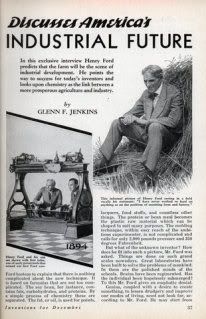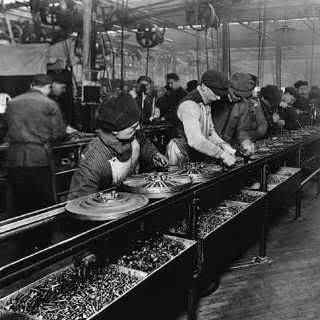| 'The best we can do is size up the chances, calculate the risks involved, estimate our ability to deal with them, and then make our plans with confidence." -Henry Ford (Quotations Books). |
Revolutionizing the American Business
Henry Ford not only brought the world on wheels, he changed the normal way of treating employees. His philosophy was that if workers were treated better, they could work more efficiently.
During the time of the World War I, labor unrest and high unemployment affected the workers (Bailey). As a result, Henry Ford pushed through by lowering the working hours from 9 to 8 and increasing minimum wage to $5 a day.

Ford believed that if workers are motivated to work, they will work their hardest and very best. In order to motivate workers, Henry Ford did something no one would have thought of doing at that time: increasing the minimum wage. "At one stroke, it will reduce hours from nine to eight, and add to every man's pay a share of the profits of the house"--This was Henry Ford's ideas. The smallest to be received by a man 22 years old and upwards will be $5 per day (Brinkley). This idea ultimately revolutionized the way many people thought about the way businesses should run. Many companies and presses were shocked and awed by what Ford did; still, Ford's employees were very happy. Because of the 5 dollar work day, absenteeism dropped as more people wanted to work (Brinkley). Productivity rose and strikes became less likely. People who heard about what Henry Ford had done, rushed to see if they were lucky enough to be hired by the Ford Company. Ford's business philosophy was so big that it was headline news in many different newspapers all around the country. In effect, other Detroit motor companies suffered high absenteeism and general destruction due to the $5 dollar day at Ford Motor Company (Watts). People left companies such as GM in order to work at Ford Company. Strikes rose at other Automobile Manufacturers as a result of people wanting to be treated just as well at Ford Motors (Watts). This allowed Ford to have the upper hand in the automobile industry. He proved himself in his own self acclaimed words: 'There is one rule for the industrialist and that is: Make the best quality of goods possible at the lowest cost possible, paying the highest wages possible' ('Henry Ford-Founder of Ford Motor Company and Assembly line Innovator').

Also, Ford was selective about his employees. He did not employ smokers and alcoholics ('Ford, Henry'). Thus, he wanted to better his company by hiring the best. Workers flocked to Ford plants, seeking jobs so Ford could choose the hardest working and smartest ones (Brinkley).
Henry Ford then went to do other things to make his employers happier. He reduced the maximum work hours from eight to nine (Watts). This was important because people in the automobile industry were working less than people in other industries, but getting paid more. Ford then went on to offer pay overtime (Watts). This was seen as crazy. The craziest thing of all, most people thought, was how Ford was still making a huge profit after putting in all of these labor reforms. The things that Ford did not have to worry about were strikes and not having enough workers for the day since his employees were happy. Ford only had to spend money on wages and the cost of building an automobile. Other companies would have to deal with constant strikes, which would cost them money due to the poor working conditions and wages. One article from the New York Times even claimed that the Ford Company was making $60,000,000 a year, which may not seem like a lot now, but was a substantial amount of money then ('Henry Ford has two objectives;'). This proved that the innovative things Ford was doing was working for him and for his company.
Most significant of all was Henry Ford's assembly line. Ford built a new factory using standardized interchangeable parts and a conveyor belt based assembly line. It would be known as 'Fordism' (Bailey). This further enabled him to increase productivity. He was able to built a car in less than 93 minutes, and would soon be producing a finished car every 24 seconds. This made cars not only affordable, but available. People could easily be able to find cars and buy them, usually off of credit. All these changes and innovations led Henry Ford to become a leading figure in the automobile industry (Allen).
